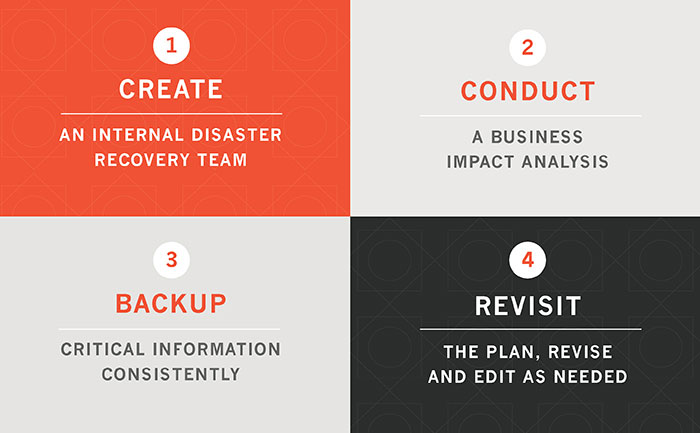2020 was filled with unforeseen events and circumstances. If we’ve learned anything, we know that strategic and adaptable planning is the key to overcoming adversities of all sizes. In the same way, developing a disaster recovery plan can help your business be prepared to navigate unexpected challenges that may come its way.
How can your business be prepared for the unexpected?
Creating and maintaining a thoughtful business continuity plan can provide a strategic framework for your company to respond to natural and manmade disasters, like earthquakes, power failures, or IT system crashes. Should an event ever occur, your business’s continuity plan should serve as a step by step process to ensure that business operations carry on with little to no disruption. Preparing an actionable plan well in advance of any unforeseen disasters can help minimize the damage and magnitude of the event on your business.
How should I develop my business’s disaster recovery plan?
Disaster recovery and business continuity plans detail the process by which your company resumes its operations after a disruptive event. Below are 4 steps you can take to begin developing and maintaining your disaster recovery plan.

- Create an internal disaster recovery team. Identify and select team members that will be responsible for creating, implementing, and keeping your business’s disaster relief plan current. Your disaster recovery team should begin by identifying potential risks to your company, including man-made emergencies, natural occurrences, and technological incidents, and developing unique responses to each that mitigate damage and restore operations.
- Conduct a business impact analysis. With the help of your internal disaster recovery team, identify your company’s vital systems and operations and the effect a disaster would have on them. Determine the time frames in which specific systems and processes must be reinstated. As you plan your disaster recovery procedures, this will help you prioritize various parts of your business and determine which elements of your company should be restored first should a disaster occur.
- Consistently backup critical information. Documents that are critical to daily operations, like vendor information, financial statements, tax returns, employee contact information, inventory records, etc., should be regularly backed up in case of a disastrous event. As you plan for disaster recovery, it is critical to set regular and frequent (i.e. monthly, weekly, or daily) data backups. This will minimize any potential loss of data, mitigating your time loss, and provide an advantage in recovery.
- Continue revisiting the plan, revising and editing as needed. As the world around your business changes, so should your disaster recovery plan. Accounting for new circumstances, environments, or threats, set a recurring date with your disaster recovery team to evaluate the established disaster recovery plan, making improvements or changes where necessary. In this way, your organization will be prepared to handle disasters with the most current information and business structure.
The path to recovery begins with your plan
When disaster strikes, being prepared to handle a fork in the road can make all the difference. Having the right strategic partnerships in place, like Westfield Bank, to manage to cash flow and a thoughtful disaster recovery plan can provide peace of mind, even if a disastrous event occurs.
About the author
Joe Bilinovich is the Senior Vice President, Market Leader at Westfield Bank, leading the business development of Westfield Bank's commercial loan and business deposit services team in the Cuyahoga and Medina County markets.



